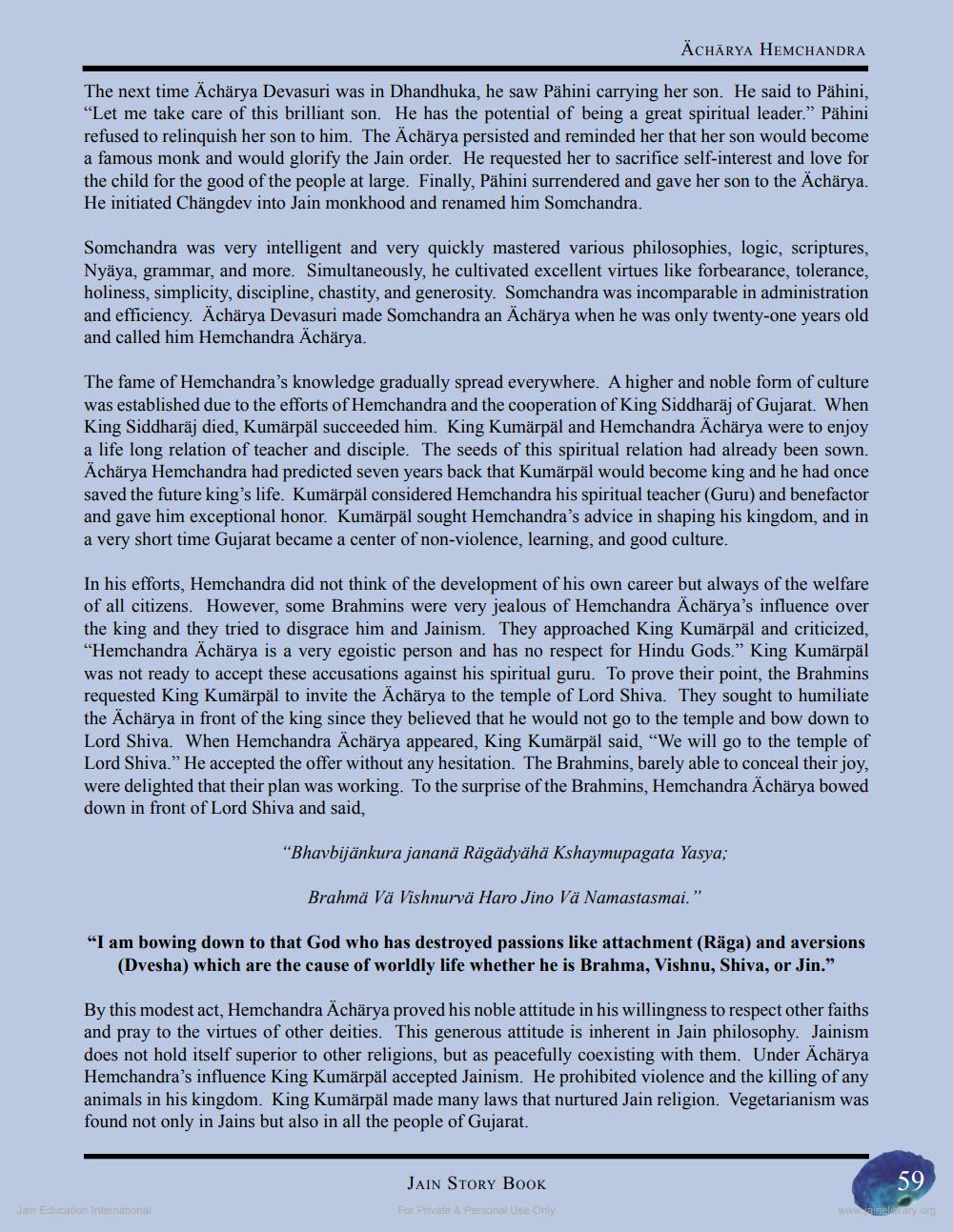Book Title: Acharya Hemchandra Author(s): JAINA Education Committee Publisher: JAINA Education Committee View full book textPage 2
________________ ÄCHARYA HEMCHANDRA The next time Ächärya Devasuri was in Dhandhuka, he saw Pähini carrying her son. He said to Pähini, "Let me take care of this brilliant son. He has the potential of being a great spiritual leader." Pähini refused to relinquish her son to him. The Acharya persisted and reminded her that her son would become a famous monk and would glorify the Jain order. He requested her to sacrifice self-interest and love for the child for the good of the people at large. Finally, Pahini surrendered and gave her son to the Acharya. He initiated Chängdev into Jain monkhood and renamed him Somchandra. Somchandra was very intelligent and very quickly mastered various philosophies, logic, scriptures, Nyaya, grammar, and more. Simultaneously, he cultivated excellent virtues like forbearance, tolerance, holiness, simplicity, discipline, chastity, and generosity. Somchandra was incomparable in administration and efficiency. Ächärya Devasuri made Somchandra an Acharya when he was only twenty-one years old and called him Hemchandra Ächärya. The fame of Hemchandra's knowledge gradually spread everywhere. A higher and noble form of culture was established due to the efforts of Hemchandra and the cooperation of King Siddharaj of Gujarat. When King Siddharaj died, Kumärpäl succeeded him. King Kumärpäl and Hemchandra Ächärya were to enjoy a life long relation of teacher and disciple. The seeds of this spiritual relation had already been sown. Ächärya Hemchandra had predicted seven years back that Kumärpäl would become king and he had once saved the future king's life. Kumärpäl considered Hemchandra his spiritual teacher (Guru) and benefactor and gave him exceptional honor. Kumärpäl sought Hemchandra's advice in shaping his kingdom, and in a very short time Gujarat became a center of non-violence, learning, and good culture. In his efforts, Hemchandra did not think of the development of his own career but always of the welfare of all citizens. However, some Brahmins were very jealous of Hemchandra Ächärya's influence over the king and they tried to disgrace him and Jainism. They approached King Kumärpäl and criticized, "Hemchandra Acharya is a very egoistic person and has no respect for Hindu Gods." King Kumarpal was not ready to accept these accusations against his spiritual guru. To prove their point, the Brahmins requested King Kumärpäl to invite the Ächärya to the temple of Lord Shiva. They sought to humiliate the Ächärya in front of the king since they believed that he would not go to the temple and bow down to Lord Shiva. When Hemchandra Ächärya appeared, King Kumärpäl said, "We will go to the temple of Lord Shiva." He accepted the offer without any hesitation. The Brahmins, barely able to conceal their joy, were delighted that their plan was working. To the surprise of the Brahmins, Hemchandra Acharya bowed down in front of Lord Shiva and said, "Bhavbijänkura jananä Rägädyähä Kshaymupagata Yasya; Brahmä Vä Vishnurvä Haro Jino Vä Namastasmai." "I am bowing down to that God who has destroyed passions like attachment (Räga) and aversions (Dvesha) which are the cause of worldly life whether he is Brahma, Vishnu, Shiva, or Jin." By this modest act, Hemchandra Ächarya proved his noble attitude in his willingness to respect other faiths and pray to the virtues of other deities. This generous attitude is inherent in Jain philosophy. Jainism does not hold itself superior to other religions, but as peacefully coexisting with them. Under Acharya Hemchandra's influence King Kumärpäl accepted Jainism. He prohibited violence and the killing of any animals in his kingdom. King Kumärpäl made many laws that nurtured Jain religion. Vegetarianism was found not only in Jains but also in all the people of Gujarat. Jain Education International JAIN STORY BOOK For Private & Personal Use Only 59 www.lainelrary.orgPage Navigation
1 2 3
